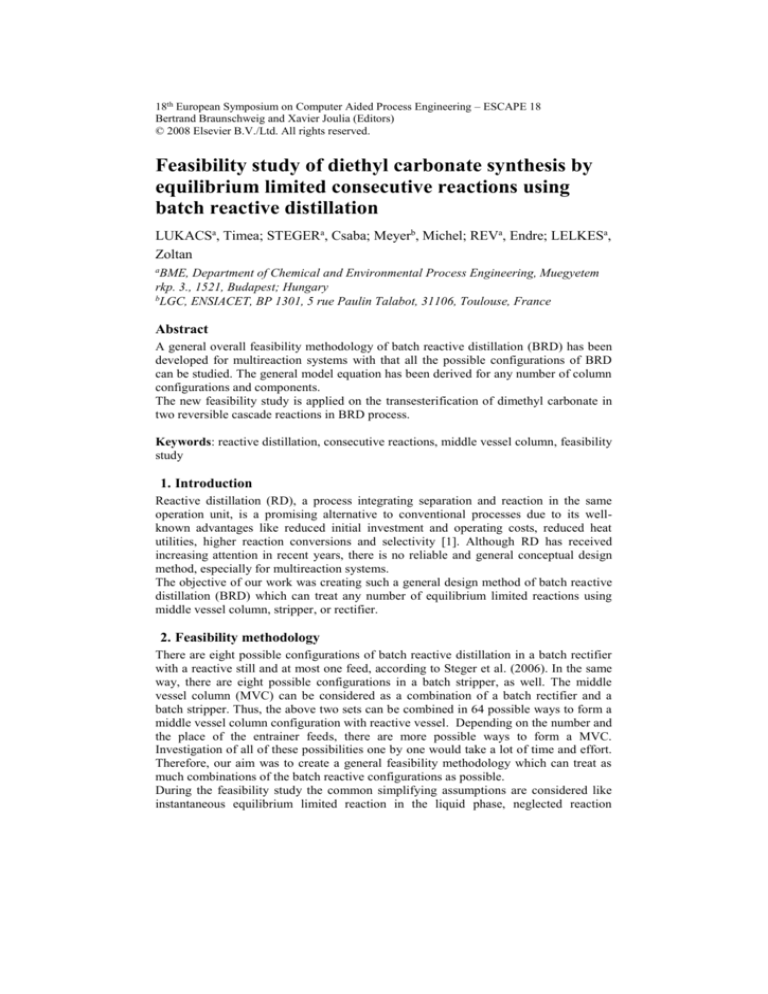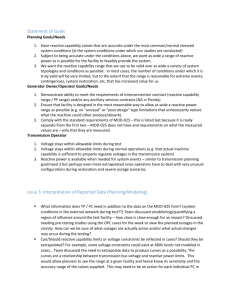
18th European Symposium on Computer Aided Process Engineering – ESCAPE 18
Bertrand Braunschweig and Xavier Joulia (Editors)
© 2008 Elsevier B.V./Ltd. All rights reserved.
Feasibility study of diethyl carbonate synthesis by
equilibrium limited consecutive reactions using
batch reactive distillation
LUKACSa, Timea; STEGERa, Csaba; Meyerb, Michel; REVa, Endre; LELKESa,
Zoltan
a
BME, Department of Chemical and Environmental Process Engineering, Muegyetem
rkp. 3., 1521, Budapest; Hungary
b
LGC, ENSIACET, BP 1301, 5 rue Paulin Talabot, 31106, Toulouse, France
Abstract
A general overall feasibility methodology of batch reactive distillation (BRD) has been
developed for multireaction systems with that all the possible configurations of BRD
can be studied. The general model equation has been derived for any number of column
configurations and components.
The new feasibility study is applied on the transesterification of dimethyl carbonate in
two reversible cascade reactions in BRD process.
Keywords: reactive distillation, consecutive reactions, middle vessel column, feasibility
study
1. Introduction
Reactive distillation (RD), a process integrating separation and reaction in the same
operation unit, is a promising alternative to conventional processes due to its wellknown advantages like reduced initial investment and operating costs, reduced heat
utilities, higher reaction conversions and selectivity [1]. Although RD has received
increasing attention in recent years, there is no reliable and general conceptual design
method, especially for multireaction systems.
The objective of our work was creating such a general design method of batch reactive
distillation (BRD) which can treat any number of equilibrium limited reactions using
middle vessel column, stripper, or rectifier.
2. Feasibility methodology
There are eight possible configurations of batch reactive distillation in a batch rectifier
with a reactive still and at most one feed, according to Steger et al. (2006). In the same
way, there are eight possible configurations in a batch stripper, as well. The middle
vessel column (MVC) can be considered as a combination of a batch rectifier and a
batch stripper. Thus, the above two sets can be combined in 64 possible ways to form a
middle vessel column configuration with reactive vessel. Depending on the number and
the place of the entrainer feeds, there are more possible ways to form a MVC.
Investigation of all of these possibilities one by one would take a lot of time and effort.
Therefore, our aim was to create a general feasibility methodology which can treat as
much combinations of the batch reactive configurations as possible.
During the feasibility study the common simplifying assumptions are considered like
instantaneous equilibrium limited reaction in the liquid phase, neglected reaction
2
T.Lukács et al.
enthalpy and liquid hold-up on the stages, instantaneous vapour-liquid equilibrium with
neglected catalyst effect.
In order to investigate all the sections, the column profiles and the still path must be
calculated with the equation presented in Table 1. The column profiles and the still path
inform us about the concentrations along the column at a given instant and the evolution
of the still path during the process, respectively. Therefore they must be investigated
together. In addition, if the studied configuration consists of more sections than one,
existence of an intersection of the section profiles, and the intersection of the still path
and the profiles next to the vessel must also be investigated according to the criteria of
Steger et al (2006).
In the spirit of the Gibbs phase rule, our reactive system with two instantaneously
equilibrium limited reactions has three degree of freedom, thus the column profiles can
be represented in a transformed space (2D). In order to obtain an overall feasibility
study with which any kind of configuration can be studied, the following transformation
that can be used for the non reactive sections, as proposed by Lelkes et al., is proposed
for multireaction systems as well:
1
~
~
an an,i an,i A NR B RR an,ref an A B 1 an,ref
N N
R
where A is the stoechiometric matrix of the components and B is the stoechiometric
matrix of the reference components.
Table 1. Model equations for column sections and still paths
Nonreactive
stripping
Non
reactive
still path
yi
LF
W
F
xi xw,i zi
V
V
V
dx MV ,i
Dx MV ,i x D,i W x MV ,i x w,i Fl x MV ,i x fl Fu x MV ,i x fu
d
dl˜i
v˜ i v˜ i
dh
Reactive
rectifying
Reactive
stripping
Reactive
still path
dxi
V
yi yi
dh L F
LF
D
F
yi
xi xD ,i zi
V
V
V
dxi
V
yi yi
dh L F
Nonreactive
rectifying
v˜ i l˜i d˜i f˜i
dl˜i
v˜ i v˜ i
dh
˜ i f˜i
v˜ i l˜ i
d˜x MV ,i
Dx˜ MV ,i x˜ D,i W x˜ MV ,i x˜ w,i Fl x˜ MV ,i x˜ fl Fu x˜ MV ,i x˜ fu
d
3. Feasibility study
The elaborated method is demonstrated on the feasibility study of transesterification of
dimethyl carbonate in two cascade reversible reactions among five components with an
intermediate methyl ethyl carbonate [2] in BRD procedure.
Feasibility study of diethyl carbonate synthesis by equilibrium limited consecutive
reactions using batch reactive distillation
3
The equilibrium limited reactions are characterized with equilibrium constants K1=2.33
and K2=0.26 obtained by our laboratory measurements.
In order to increase conversion by shifting the equilibrium limited reaction, use of MVC
is suggested. The objective of this study is to examine the feasibility of the
simultaneously producing MeOH and DEC in MVC. The purity of both products is
specified to 95%.
Although any kind of configuration can be studied with the proposed method, here the
configurations mentioned above only are studied.
3.1. Total reflux analysis
The case of total reflux is easier and can be considered as limit case to great reflux
ratios.
3.1.1. Investigation of the non-reactive sections
The studied system consists of five components. Thus, visualization of the residue
curves is problematic in either 3D or 2D. With the knowledge of the boiling points of
the azeotropes and the pure components, the singular points and thus the evolution of
the residue curve map of the non reactive system can be determined. In order to make
the visualization easier, the system is projected to 2D (Figure 1). According to this
projected network, six saddle points, one stable node (denoted by SN) (DEC), and one
unstable node (denoted by UN) (azeotrope of DMC-MeOH) have been found.
The desired products are DEC and MeOH as bottom product and distillate, respectively.
Since the SN of the system is DEC, producing pure bottom product is feasible.
Contrarily, since the MeOH vertex is a saddle, pure distillate cannot be withdrawn from
a non-reactive rectifying section. The top product would be near the UN, i.e. the
azeotrope of DMC-MeOH.
DMC
DMC
DEC
EtOH
DEC
MEC
MEC
MeOH
DMC
DMC
EtOH
DEC
EtOH
DEC
EtOH
DEC
MEC
MEC
MeOH
DMC
DMC
EtOH
DEC
EtOH
MEC
MEC
Figure 1.The non reactive RCM unfolded in 2D.
3.1.2. Investigation of the reactive sections
The proposed transformation enables the reactive residue curves maps to be shown in
2D (Figure 2). The reactive space contains the same singular points as in the case of the
non-reactive system. Thus, only the DMC-MeOH azeotrope and pure DEC can be
withdrawn with infinite number of theoretical stages.
Although MeOH as a desired product appears as a saddle point in the system, nearly
pure MeOH can be withdrawn with the use of EtOH as an entrainer. With a feed ratio
F/V=0.3, the extractive profiles intersect the rectifying profile running nearby the
EtOH-MeOH edge from which the desired product can be reached, as is shown in
Figure 3. Thus, using entrainer, the desired distillate can be withdrawn from the whole
part of the quadrangle.
4
T.Lukács et al.
DMC
DMC
MEC
Total reflux
F/V=0.3
MEC
reactive extractive
profiles
UN
DEC
MeOH
SN
Saddle
DEC
MeOH
Saddle
residue curve
(xd=0.95)
EtOH
SNex
EtOH
Figure 3. Extractive profiles map at total
relux ratio (F/V=0.3)
Figure 2. The reactive RCM
3.2. Finite reflux analysis
With finite reflux analysis, the main operation parameters namely reflux ratio, reboil
ratio, and feed ratio, are also determined during the feasibility study, and they can be
used to determine a nearly optimal feed policy.
Since graphical method cannot be used in our case for the investigation of the nonreactive sections, only the feasibility of the fully reactive configurations is studied.
3.2.1. Determination of reflux, reboil ratio and corresponding feed ratio
For the production of nearly pure MeOH, extractive stages are needed in the upper
section of the MVC, see chapter 3.1.2. With a reflux ratio R=5 and with a feed ratio
F/V=0.2, most of the extractive profiles intersect the rectifying profile derived from the
destination region, and thus it gives a feasible region satisfying large, presented with
shaded area in Figure 4.
Since the vertex DEC is the only stable node in the system, the feasibility is not
constrained by reboil ratio (denoted by S), but the size of the feasibility region decreases
with it. The application of EtOH as an entrainer in the lower part of the MVC may
increase the feasible area in this case, as well. Only those extractive profiles give pure
DEC which cross the stripping profiles derived from the desired product composition.
Using a reboil ratio S=10 and a feed ratio F/L=0.3, the feasible region has been found
large enough for the production of DEC (Figure 5).
DMC
DMC
S=10
F/L=0.3
R=5
F/V=0.2
MEC
MEC
destination
region
reactive extractive profiles
MeOH
DEC
MeOH
reactive extractive
profiles
Saddle
DEC
SN
destination region
reactive rectifying profile
(xd=0.95)
EtOH
Figure 4. The extractive profiles map at
finite reflux ratio (R=5, F/V=0.2)
EtOH
reactive
stripping profile
(xw=0.95)
Figure 5. The extractive profiles map at
finite reboil ratio (S=10, F/L=0,3)
3.2.2. Determination of the product ratio
In the case of a MVC, the feasible region of the middle vessel (MV) is given by the
intersection of the feasible regions of the sections right next to the MV, as it is shown
with shaded area in Figure 6. Calculation of the still path by integrating the differential
equation has been started from the following initial composition:
Feasibility study of diethyl carbonate synthesis by equilibrium limited consecutive
reactions using batch reactive distillation
5
x0(DEC,DMC,EtOH,MEC,MeOH)=[0.013 0.160 0.184 0.134 0.509]. The product ratio varies
in order to investigate the evolution of the still-path. The product ratio D/W=10 seems
to be an optimal value for the simultaneous production, according to the feasibility
calculation.
DMC
MEC
R=5
F/V=0.2
S=10
F/L=0.3
MeOH
DEC
D/W = 0.1
D/W = 1
D/W = 100
EtOH
D/W = 10
Figure 6. The feasible MV region and the still path with different product ratios
3.2.3. Determination of the number of theoretical stages
Although the number of theoretical stages (Nth) does not have any effect on the
feasibility, it is an important factor to estimate the efficiency of the process. The number
of theoretical stages has been calculated using a stage-by-stage model with the
parameters mentioned above. The maximum and the minimum stage numbers in the
rectifier are 56 and 30, respectively. The number of theoretical stages in a stripper, and
the extractive stage numbers in the upper and in the lower parts of the MVC are
between 10 and 20, 6 and 16, and 5 and 10, respectively.
4. Conclusion
The feasibility method of BRD has been extended for consecutive reactions. The
general model equation has been derived for multireaction system in consideration with
any number of chemical equilibrium limited reactions.
The new feasibility methodology has been validated on the consecutive reactions of
transesterification of dimethyl carbonate in batch reactive MVC. As a result of the finite
reflux analyses, the main operational parameters have also been determined, and are
collected in Table 2.
The general methodology is elaborated as a graphical method. The feasibility study of
the system with more than 3 degrees of freedom might be complex in practice; thus,
further investigation is needed for these kinds of systems.
6
T.Lukács et al.
Table 2. The main operational parameters of the studied system
Parameter
R
F/V
S
F/L
D/W
Nth in rectifier
Extractive Nth in rectifier
Nth in stripper
Extractive Nth in stripper
value
5
0.2
10
0.3
10
30-56
6-16
10-20
5-10
References
F.M.Malone and M.F. Doherty, 2000, Design minimum reflux calculations for single fee
multicomponent reactive distillation columns, Ind. Eng. Chem. Res. 39. 3953-3957
Cs. Steger et al.,2006 Feasibility study of batch reactive distillation in hybrid columns, ESCAPE16
Z. Lelkes et al., 1998, Feasibility of extractive distillation in a batch rectifier, Aiche J., 44, 810822
V. Varga at al., 2006, Separation of azeotropes in batch extractive stripper with intermediate
entrainer ESCAPE-16
H-P. Luo and W-D. Xiao, 2001, A reactive distillation process for a cascade and azeotropic
reaction system: Carbonylation of ethanol with dimethyl carbonate, Chem. Eng. Sci. ; 56, 403410
Barbosa and Doherty,1988, The simple distillation of homogeneous reactive mixtures, Chem.
Eng. Sci., 43, 541-550
H. Schmidth-Traub and A. Gorak, 2006, Integrated reactive and separation operations, Springer









